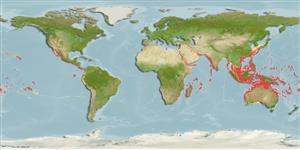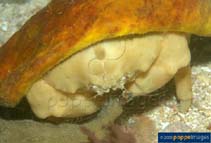Tumidodromia dormia (Linnaeus, 1763)
Common sponge crab| Native range | All suitable habitat | Point map | Year 2050 |

|
| This map was computer-generated and has not yet been reviewed. |
| Tumidodromia dormia AquaMaps Data sources: GBIF OBIS |
Classification / Names Common names | Synonyms | CoL | ITIS | WoRMS
Malacostraca | Decapoda | Dromiidae
Environment: milieu / climate zone / depth range / distribution range Ecology
Benthic; depth range 5 - 112 m (Ref. 3174). Tropical
Distribution Countries | FAO areas | Ecosystems | Occurrences | Introductions
Indo-Pacific: From the Red Sea and East Africa to Hawaii and French Polynesia.
Length at first maturity / Size / Weight / Age
Maturity: Lm ? range ? - ? cm Max length : 20.0 cm CW male/unsexed; (Ref. 3174); 17.2 cm CW (female)
Short description Morphology
Carapace rounded, as wide as or slightly wider than long; surfaces convex, with dense pubiscence; 5 anterolateral teeth, median ones largest. No spine present on outer margin of dactylus of last walking leg. Color: light brown overall with pink fingers.
Largest dromiid known (Refs. 343, 122680). Epizoic. Subtidal on hard bottom (Ref. 106854). Occurs at depths of 5 to 50 m. Prefers moderately shallow waters with rocky-muddy substrates, sometimes near reefs. Omnivorous, feeds on sea stars. Carries sponges and colonial tunicates on its back for camouflage (Ref. 343). Can occasionally be found sheltering under old bivalve shells (Ref. 125338). Predator (Ref. 128960).
Life cycle and mating behavior Maturity | Reproduction | Spawning | Eggs | Fecundity | Larvae
Members of the order Decapoda are mostly gonochoric. Mating behavior: Precopulatory courtship ritual is common (through olfactory and tactile cues); usually indirect sperm transfer.
Main reference
References | Coordinator | Collaborators
Ng, P.K.L. 1998. (Ref. 343)
IUCN Red List Status (Ref. 130435)
CITES status (Ref. 108899)
Not Evaluated
CMS (Ref. 116361)
Not Evaluated
Threat to humans
Human uses
Fisheries: minor commercial
| FishSource |
Tools
More information
Internet sources
BHL | BOLD Systems | CISTI | DiscoverLife | FAO(Publication : search) | Fishipedia | GenBank (genome, nucleotide) | GloBI | Gomexsi | Google Books | Google Scholar | Google | PubMed | Tree of Life | Wikipedia (Go, Search) | Zoological Record
Estimates based on models
Preferred temperature
(Ref. 115969): 22 - 29, mean 27.8 (based on 1662 cells).
Price category
(Ref. 80766):
Unknown.



